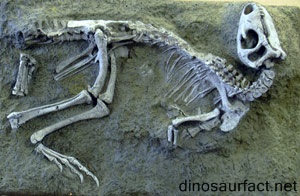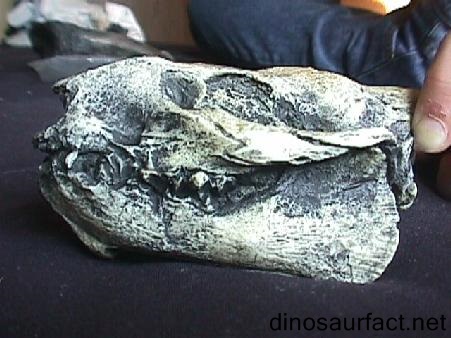 Click to visit the previous dinosaur bio
Click to visit the previous dinosaur bio
 |
|
 |
|
Kingdom: Animalia
Phylum: Chordata
Class: Sauropsida
SuperOrder: Dinosauria
Order: Ornithischia
SubOrder: Neornithischia
Genus: Nanosaurus
 |
|
 |
|
 |
|

Nanosaurus (pronounced nan-uh-sore-us) was possibly one of the smaller dinosaurs to have existed in the clan of these giant creatures. Fossil records suggest that they were anything around two feet tall and four feet long. Most of the people believe these creatures to be anything around the size of an average sized dog of today mostly so because mostly they have been referred as such in most of the popular books. In depth studies suggest these animals were herbivores in nature. They probably survived most possibly on shrubs and small plants. They could also have fed on small animals and insects.
The name Nanosaurus was accepted from the fossil findings of a jumbled skeleton that was discovered in the hard sandstone region of the Cope area. It was basically used as a synonym for ‘Dwarf Lizard’.
Most of the Nanosaurus fossils have been found in Colorado and parts of Wyoming. This is not a huge area as a matter of fact they mostly are believed to be originated from west central region of North America during 150 million years ago in the Late Jurassic Period.
Fossil studies suggest that Nanosaurus belonged to Genus Ornithopod. Basically Ornithopod was more of a poorly known genus. It should be mentioned that Camptosaurus was one among them. Camptosaurus was mostly herbivorous by nature.
A partial skeletal fossil of Nanosaurus was discovered in Golden Park by Lucas, more commonly known as Lucas quarries. This is said to be the only valid species of the genus Nanosaurus and was named Nanosaurus agilis. This fossil consists of a jawbone, a partial pelvis and a few limb bones. These remains were mostly fragmented and hence the later reconstruction of the animal was made based on observations of characters that closely resemble Othnelia.
- Ophelia was a name given for Othniel Charles Marsh and the Othniela species fossils were also present in Garden Park.
- Mr Carpenter in 1995 played a critical role in the reconstruction of Nanosaurus as he used another dinosaur of English origin, Hypsilophodon and compared it as a model for Nanosaurus construction. Carpenter made an estimate that the Nanosaurus would be around two feet in length and would have weighed somewhere around five pounds.
However Oramel Lucas actually sent the fossilized remains of the would be Nanosaurus agilis to Dr. Marsh instead of Dr. Cope after being reportedly convinced by Mr. Mudge to do so. Mr. Mudge by the way happened to be Marsh’s employee. It can be well mentioned in such a context that Nanosaurus agilis hence ended up being the first dinosaur in Garden Park to be named by Marsh.
It should be however noted that the super-order Dinosauria was divided into Ornithischia and Saurischia (Harry Seeley 1887). The basis of this division was based on evolutionary evidence of pelvis into a bird like structure. A predatory bone is present in the front of the lower jaw extending to the main lower jaw bone.
It was actually Marsh who named three species belonging to the genus Nanosaurus min 1877. Marsh also went to the extent of setting up a separate family named Nanosauridae and placed only Nanosaurus within them. However things went against the tide in 1881 as Nanosaurus victor which was actually believed to belong to nanosauriadae family got reassigned systemically. N. Victor was recognized to be completely different from the other Nanosaurus. It is now known as a small bipedalled crocodile like Hallopus sp. After this episode of reassignment there has been a complete halt to the discussion of Nanosaurus. Later Nanosauridae was later renamed to Hypsilophodontidae after the death of Marsh.
- It should be mentioned that Jim Jenson and Peter Galton carried out a study in 1973 on a partial skeleton. The skeletal fossil was devoid of any hands head and the tail. They presumed it to be that of Nanosaurus rex. However by the end of 1977 Galton came to the conclusion that Nanosaurus agilis was very different from N. Rex. He named it Othnelia for the new species in place of N. rex.
- Paul Sereno was a notable scientist who opined the fossil as that of a dubious ornithischian or a hypsilophodont.
- However as per recent findings, Galton in 2007 made a conclusive statement to the fossil study and considered to be a basal ornithopod. He also pointed out that there are some basal similarities with the thigh bone of Heterodontosaurids. Galton also assigned some teeth that are reportedly belonging to Drinker.
- On the basis of ossification Galton came to the conclusion that these Nanosaurus were primarily small animals and possessed bipedal and cursorial movements.
Nanosaurus remains an uncertain and as some say a dubious entity of a dinosaur that have possibly been belonging to the Ornithopod family. To summarize the sequence of discoveries, three species namely Nanosaurus rex, Nanosaurus agilis, Nanosaurus victor had been previously discovered. Later N. rex was used to create the genus Othniella (1977). N. victor was also realized to be somewhat similar to crocodilian remains. N.agilis is only the remaining of the lot. Again the study of N. agilis remains very vague as their study is based very much on fragmentary remains and ornithischian reconstructions. As a whole it yet remains a very problematic approach to ascertain a genus on such low specific features.
To conclude the story it should be mentioned that there are various schools of thought who have strong opinions regarding the naming of Nanosaurus or rather wasting such a catchy name. Many experts consider this as a dubious naming till date. A recent re-examination of the fossils has once again confirmed that it still bears striking resemblance to Othniela. Some have already concluded that both the species are the same. Again there is another group of experts who are of the opinion that Nanosaurus was nothing but the same fossil of the specimen Drinker, which was quite amusingly named by Marsh’s arch rival or as they call him in the context of ‘The Bone Wars’, Dr. Edward Drinker Cope.
Index
Extinct Profiles
 Triassic Dinosaurs
Triassic Dinosaurs Jurassic Dinosaurs
Jurassic Dinosaurs Cretaceous Dinosaurs
Cretaceous Dinosaurs Pterosaurs
Pterosaurs Marine Reptiles
Marine Reptiles Dinosaur Extinction
Dinosaur Extinction